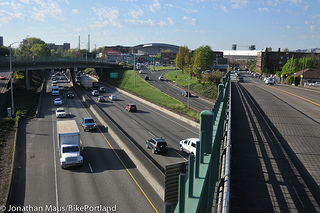
could take a big step forward tomorrow.
(Photo © J. Maus/BikePortland)
On Wednesday, a plan by the Oregon Department of Transportation to widen I-5 near the Rose Quarter will be considered for adoption by City Council. The I-5 Broadway/Weidler Facility Plan, which includes freeway and surface street changes that are estimated to cost $400 million, will be considered in tandem with the N/NE Quadrant Plan, an effort by the City of Portland’s Bureau of Planning and Sustainability to re-imagine transportation and land-use in the lower-Albina and Lloyd districts.
While passage of both plans is likely, the key component of the I-5 Facility Plan — the widening of the freeway between I-84 and the Fremont Bridge — is not supported by local grassroots group Active Right of Way (AROW). A City of Portland Planning Commissioner also voted against the facility plan when it came before the City’s Planning and Sustainability Commission last month.
In a minority opinion statement issued to City Council, Planning Commissioner Chris Smith (a well known transportation activist who made a run for City Council back in 2008) cited two main reasons for his no vote. Smith said instead of just adding lanes and widening shoulders, the project should have used transportation demand management (TDM) measures, (such as trip reduction strategies and traffic management technology). According to ODOT, I-5 needs to be widened in order to increase capacity and reduce collisions. However, TDM measures were not considered because given traffic volume projections, ODOT didn’t think they’d be effective.
“Recommending a project of this size without knowing if it is in alignment with our climate plan is a bad idea.”
— Chris Smith, City Planning Commissioner
Smith feels ODOT’s decision to reject TDM from the outset was flawed because they based travel demand on projection models that don’t align with the City’s adopted Climate Action Plan. “ODOT’s model showed too much latent demand,” he wrote in an email explaining his “no” vote, “But… the Portland Climate Action plan aspires to a lower level of VMT [vehicle miles traveled].” Smith points out that since there are no detailed models of what a lower VMT would look like, the project team had no way to accurately understand the projections.
“Recommending a project of this size without knowing if it is in alignment with our climate plan is a bad idea.”
Smith’s other reason for objecting to the I-5 expansion is a simple cost/benefit equation. ODOT has stated throughout this process that their number one concern is “safety”. The narrow lanes and the short spacing between on/off-ramps, they say, lead to too many collisions. If safety is ODOT’s goal, Smith contends, “A much greater improvement in safety could be achieved by taking the price tag of the freeway project and spreading it around in a large number of much smaller safety projects around the City. This is simply not a good return on the tax dollars that would be invested.”
AROW volunteers Steve Bozzone and Alexis Grant agree.
“Although this project is billed as a safety project, only the safety of the freeway has been truly considered,” reads a letter sent to City Council and ODOT last month signed by Bozzone and Grant. They also cite the project’s expense, the lack of TDM measures, public health concerns and the lack of neighborhood-level stakeholders.
At this point, this is just a concept plan. No money has been guaranteed. But an endorsement from City Council would all but assure that the plan finds a place near the front of the future funding line. One big question on the table is how ODOT will prioritize implementation of the various elements of the plan. In addition to the I-5 widening, the plan also includes significant changes to the surface streets, including a new bike-only path over the freeway, a complete re-route of Flint, changes to N Williams Ave and more.
If and when funding becomes available, will ODOT do the freeway widening first, and forget about the promised surface street improvements? I’ve asked ODOT project manager Todd Juhasz for clarification on this (as well as a breakdown of the costs) and have yet to hear back.
——
When the public process for this plan first got underway nearly two years ago, I was skeptical of ODOT’s intentions. They have been wanting to widen I-5 through the Rose Quarter for decades, but past plans never got too far. With the N/NE Quadrant Plan getting an update, ODOT found a perfect way to cloak their desire to “fix” this notorious “bottleneck” in a kinder, gentler planning process, using the City of Portland’s less highway-centric image as a buffer.
Was this a slick PR move used to finally get their freeway widened? Maybe.
But there’s another way to look at this. Isn’t this how we should want ODOT to plan freeway projects? By integrating them tightly with land-use plans? Or perhaps the issue isn’t how the freeway expansion is being planned, but simply that it’s being planned at all.
You can view the I-5 facility plan on the project website. The public is invited to a testify at the City Council hearing tomorrow:
- City Council Public Hearing – Testimony Welcome
N/NE Quadrant and I-5 Broadway-Weidler Plans
Oct. 25, 2012, 2 p.m.
Council Chambers (City Hall, 2nd Floor)
1221 SW Fourth Avenue

